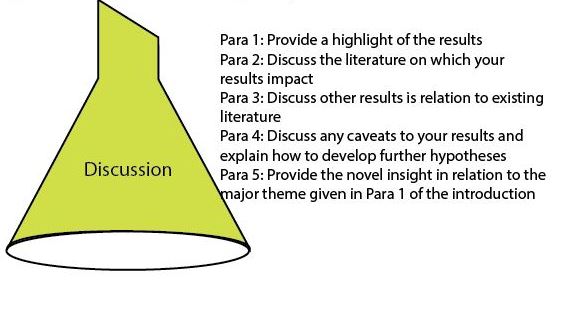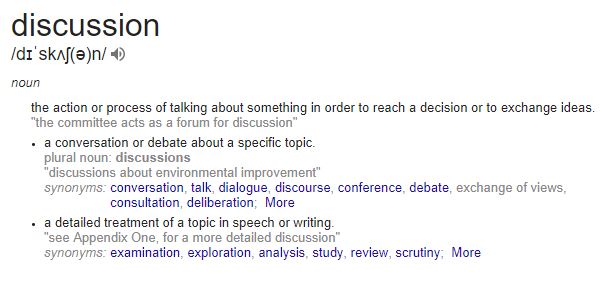Writing the discussion can be a daunting prospect
Writing your discussion
The discussion should be the last part of your manuscript or chapter that you are going to write. This is because for the discussion you must already know all of the rest of the manuscript, starting with the hypothesis, which dictates what will go into all of the other sections. While writing the other sections, I often make notes under the heading ‘discussion’ so that it acts as an aid memoire to ideas that I’ve had during the study.
Before you start writing your discussion, make a plan and then discuss this plan with your advisor. I’d make this suggestion for all of the sections of your chapter or paper. It doesn’t take that long to do, and it provides an opportunity for you and your advisor to talk about the results of your work and discuss them together. Such discussions should be eye opening for both of you, and they provide a great opportunity for you and your advisor to get excited about the work you’ve done, your results and what they mean. I get a lot enjoyment during these discussions, especially when sharing the excitement of the results. Sharing thoughts before you start writing is important because by talking about it, you and your advisor are more likely to come to a consensus about what the results mean. Conversely, presenting them with the discussion finished might not be the best way of convincing them, and you might have a lot more work to do in the long run.
In general, the first and last paragraphs of the discussion are key to the reader, but the discussion must also consider caveats and limitations in the experimental design and interpretation of your results, as well as providing a concise discussion of the results in the context of existing literature. This is also your opportunity to suggest new hypotheses and how they could be tested.
Let's remember that if you are struggling to write, there is the potential to follow a formula, such as the one I outlined previously (see blog post here).
First paragraph of discussion
You discussion begins by you responding to your hypothesis, clearly stating whether or not it has been accepted, and putting this into the wider context of the study (i.e. paragraph one or two of the introduction with relevant literature). You can then follow these statements by emphasising what you consider to be the most important finding, and explain how it adds to existing literature. However, don’t be tempted to over-interpret your results, or claim that they mean more than they do (see section on speculation below).
This first paragraph of the discussion doesn’t have to be very long (three to four sentences), but you should make sure that you end by providing a link to the following paragraph or explaining how you will move the discussion on in sections.
To sub-section or not to sub-section the discussion?
My preference is to plan the discussion before you write it, just as you did for the introduction. This will provide you with logical sub-section headers for the discussion. When your chapter has a simple aim that is easily communicated, I’d suggest deleting these sub-section headings before you finish. However, many studies are more complex and contain multiple experiments or evidential approaches. It is then much easier to leave sub-sections in your discussion so that your reader can more easily follow the text. Where possible, these should be the same sub-sections that you have broken your methods and results into, especially where these relate to specific hypotheses or aims. Or it may be more appropriate to discuss the different approaches separately, specifically when the literature that you refer to falls into different groups.
If you are stuck and can’t decide which way is most appropriate for your work, spend more time on fleshing the outline specifically to include the literature that you want to cite. Try it one way, and then the other, and you should quickly be able to tell which makes more sense. Of course, you should also ask your advisor for their opinion – that’s what they are there for, after all.
When considering what sub-section to write first, go back to the order that you’ve presented the questions or approaches in the rest of your chapter or manuscript. Keeping the order consistent throughout is a really good way of helping your reader follow what you want to communicate. Shuffling the order in each section is almost guaranteed to get them lost and wishing that they hadn’t started reading.
Then you need to discuss!
The discussion is about explaining the meaning of your results to the reader. I often find that people write a lot of inappropriate information in the discussion. Remember that this section is not going to provide background information, and is unlikely to bring up new topics that need introducing. It may be that your results prompt you to introduce a new area of research that wasn’t covered in your introduction, and this is fine. But for the main part, you should discuss your results in the context of existing literature. You can expect that the literature that you use in your discussion will only partially overlap with your introduction, with plenty of new citations. Similarly, it can be that discussing your results will mean that you end up with paragraphs that have no citations.
When providing different sides of an argument, try to use your results come to conclude that one side is supported more than the other. If your results don't help with this particular point, then it could be that you are trying to discuss something that isn't directly related to the work. This is a very common problem in discussions, and a good test is asking yourself how your results add to the point you are trying to discuss. If they don't leave it out and move on.
Caveats and limitations
An important aspect of the discussion is to consider how the interpretation of your results may be incorrect. For example, if you have done an experiment, how well controlled was it and how well could it be considered to scale up to real world interactions? Could you have measured other variables? Almost every study will have caveats and limitations, and it is very important that you report them in a considered approach.
My preference is not to provide all the caveats and limitations as a separate paragraph. Instead, mention them when you are discussing relevant aspects.
Should you speculate in the discussion?
Reviewers will often be unhappy with speculation in the discussion section. Speculation isn’t that hard to spot, as it occurs when you make claims for which your results have no foundation. I think that it is healthy to have one or two statements that are speculative, but clearly labelled as such. After all, after writing this paper, you are going to be one of the world experts in the topic, and thus your deeper understanding is often worth relating to the reader. However, I suggest that you speculate in combination with suggesting what could be done in future. If you really feel that the point has to be made, you must clearly label it as speculative.
Perhaps an easier trap to fall into is over-interpretation. This is when you suggest that your results mean more than they do. It’s an easy trap to fall into, especially after setting up the study in relation to key topics in the discipline (presented in paragraph one or two of the introduction). You will probably find it hard to see where you have over-interpreted, and this is something that having your work read by your advisor, or another colleague, will really help. You may then be asked to ‘tone down’ your claim, or to place it into the direct findings of your results.
Again, my preference is not to place all speculations or future hypotheses in the same paragraph of the discussion. These aspects should appear as the topics they relate to are discussed.
Don’t beat up on others
Your results may show that other researchers were wrong with their interpretation or findings. Whatever you may think of them, never use your discussion to be disrespectful to other researchers or their work. This has been referred to as the “bully pulpit” (see here). As with all aspects of professional interactions, consider how you would like to be treated, and act accordingly. This is not to say that you shouldn’t point out mistakes that were made before, but be sure not to get emotive or insulting.
Generally, such comments won’t get through the peer review process, and remember that you might be insulting the examiner of your thesis (or the reviewer of your paper) – which is not likely to go down well!
Where next?
The ‘where next’ aspect of your discussion is important as it may provide the reader with ideas for their own work. Of course, these are questions that you may wish to pursue in your own career, or they may be corroborating evidence from other disciplines that you will never undertake. Either way, making pointers for continuing aspects of the research is an important component of the discussion. Providing new lines of research may also allow you to speculate about what you consider to be the most important angle of this topic now that you have presented your results.
Last paragraph
The last paragraph of the discussion is your take home message. It’s a summary paragraph that sets out what you aimed to achieve, and what the new state of understanding of the topic is now that your results are out. This should include the key literature that can now be reconsidered.
Never repeat text
Please remember that while this might sound similar to your first paragraph, it is not the same. This final paragraph should not replicate any text that appears elsewhere in your chapter or manuscript (not even the abstract). Never repeat or copy text generally, even within your own chapter (or between chapters). For the reader, it’s very easy to spot and it gives the impression that you have nothing to say and are simply filling space. This is not the kind of impression that you want to give your reader, especially if they are examining your work!
As always, there are a number of other places to look for more advice to writing your discussion, and I’d encourage you to read as widely as possible. Here are just a few that I’ve looked at after writing the first draft of this blog post:
Hess, DR 2004. How to Write an Effective Discussion Respiratory Care 49:1238-1241.
Şanlı, Ö et al, 2013. How to write a discussion section?. Turkish journal of urology, 39 (Suppl 1): 20-24.


